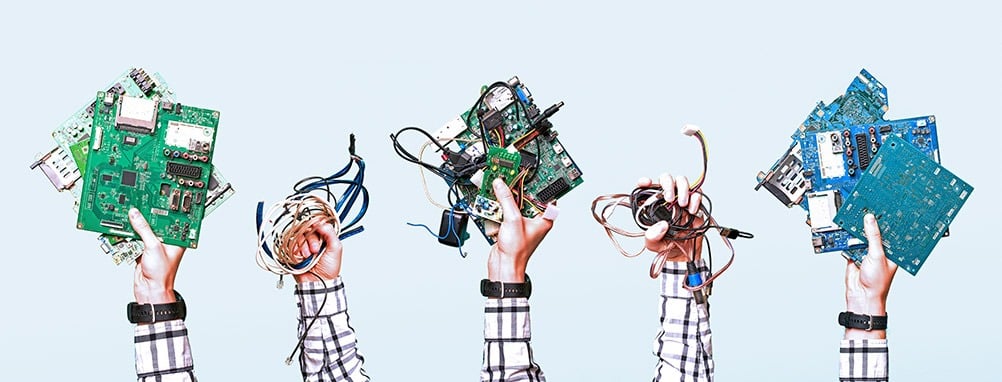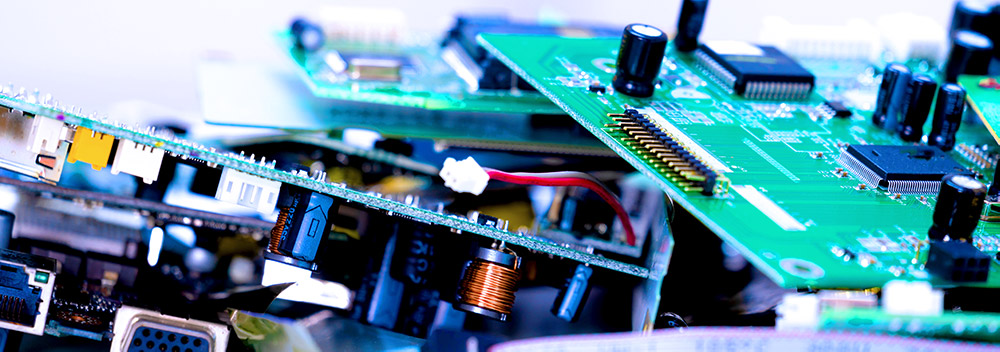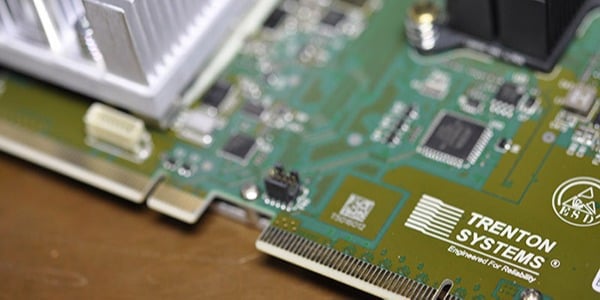Share this
10 Shocking Facts About Counterfeit Electronics [Defense & Aerospace]
by Brett Daniel on Feb 18, 2021 10:12:27 AM

Photo: Counterfeit electronic parts can have direct, sudden, and devastating effects on national security and critical infrastructure if not identified, removed, and replaced during manufacturing.
Table of Contents
- 10 Shocking Facts About Counterfeit Electronics
- What can be done about counterfeit electronics?
- What is Trenton Systems doing to avoid counterfeit electronics?
The use of counterfeit electronic parts in defense systems can compromise performance and reliability, risk national security, and endanger the safety of military personnel.
We've discussed the counterfeit electronic parts industry, the multibillion-dollar black market that continues to adulterate the defense and aerospace supply chain.
If that blog post wasn't enough to disturb you, take a moment to absorb these 10 shocking facts about counterfeit electronic parts and their impact on the defense and aerospace markets.
Stick around to learn more about what Trenton Systems is doing to prevent counterfeit electronics infiltration.
10 Shocking Facts About Counterfeit Electronics
- A 2011 Senate Armed Services Committee investigation found that China is the dominant source country for counterfeit electronic parts infiltrating the defense supply chain. More than 70 percent of the suspect parts analyzed during this investigation were traced back to the country.
- That same 2011 Senate Armed Services Committee investigation also identified 1,800 cases of counterfeit electronic parts throughout the defense supply chain, the vast majority of which went unreported to the DoD or criminal authorities. These cases amounted to more than 1 million suspected counterfeit electronic parts.
- In the semiconductor industry, an estimated $7.5 billion is lost in revenue each year because of counterfeit parts, according to the Semiconductor Industry Association (SIA).
- Counterfeit electronic parts cost the American taxpayer $2.7 million in 2010 when the Missile Defense Agency (MDA) learned mission computers for Terminal High Altitude Area Defense (THAAD) missiles contained counterfeit memory devices. The MDA had no choice but to replace the parts to prevent a potentially catastrophic missile failure.
- An estimated 15 percent of all spare and replacement electronic parts purchased by The Pentagon are counterfeit.
- The Senate Armed Services Committee investigation also discovered numerous counterfeit electronic parts from China in the Air Force's largest cargo plane, in assemblies intended for Special Operations helicopters, and in a Navy surveillance plane.
- The Senate Armed Services Committee investigation also found that 84,000 suspect counterfeit electronic parts were inserted into the DoD supply chain by a single electronic parts supplier, Hong Dark Electronic Trade, of Shenzhen, China. These parts were found in Traffic Alert and Collision Avoidance Systems (TCAS) intended for the C-5AMP transport aircraft, C-12 logistics support aircraft, and the Global Hawk remotely piloted aircraft (RPA).
- In 2011, L3Harris Technologies reported that the U.S. Air Force Joint Cargo Aircraft C-27J program had experienced four instances of suspect counterfeit electronic parts since the program's inception in 2007. These parts were found in avionics systems, Color Multipurpose Display Units (CMDU), and a Type 1 Bus Adapter Unit (BAU).
- Raytheon had to pay $750,000 to remediate a counterfeit part intended for the Stryker mobile gun system vehicle.
- Raytheon also reported in 2011 that a total of 32 counterfeit parts had entered into its supply chain during the previous two years.
BONUS FACTS:
- Hundreds of thousands of American jobs are lost each year because of counterfeiting.
- U.S. companies lose $200-250 billion in revenue each year because of counterfeit parts.
Sources: The Senate Armed Services Committee's Investigation Into Counterfeit Electronic Parts In the Department of Defense Supply Chain; Senate Armed Services Committee Releases Report on Counterfeit Electronic Parts

Photo: The Pentagon has several initiatives in place to prevent counterfeit electronics infiltration, but prevention efforts also fall on the shoulders of contractors and their suppliers.
What can be done about counterfeit electronics?
The proliferation of counterfeit electronic parts within the DoD supply chain is difficult to control because counterfeit parts are designed to appear legitimate and function somewhat adequately, at least for a little while.
But such parts are ultimately unreliable, unvetted, and, in the case of the defense, aerospace, and government markets, could quickly and suddenly destabilize critical infrastructure, compromise national security, and cause severe injury or death. They also pose a significant cybersecurity threat.
The Pentagon continues to focus on cutting down the number of counterfeit electronic parts that enter the defense supply chain with measures like plant DNA, the Trusted Foundry program, the Supply Chain Hardware Integrity for Electronics Defense (SHIELD) program, and more recently, a zero-trust approach.

Photo: Trenton Systems has numerous policies, procedures, and practices in place to avoid counterfeit electronics infiltration, supply chain attacks, and the resulting cybersecurity ramifications.
What is Trenton Systems doing to avoid counterfeit electronics?
Trenton Systems, a supplier of secure, high-performance computing solutions for military primes, aerospace companies, and other defense contractors and subcontractors, has several policies, practices, and procedures in place that protect our hardware against supply chain attacks and counterfeit electronic parts infiltration.
Number one is our supplier quality surveys, which involve vetting and verifying our suppliers' quality control systems, procedures, practices, and certifications.
We vet and qualify all of our suppliers so that we can add them to our approved vendor list (AVL). With anyone that we purchase from, whether it's a physical product or a service, we must have official documentation from that company, and from us, on file that outlines that vetting process. Part of this process involves send out a five-page survey that provides us with an overview of the company's capabilities and quality system, including what processes and procedures they have in place, what certifications they have, whether they're an ISO facility, and other critical supply chain factors that determine whether they're a trusted source with whom to do business.
 Toni Hauck, Director of Quality Control, Trenton Systems
Toni Hauck, Director of Quality Control, Trenton Systems
Number two is our Counterfeit Protection Program (CPP). The purpose of the CPP is employee awareness, training, and understanding of counterfeit electronic parts, such as learning how counterfeit electronic parts enter the industrial supply chain and how we, as a leading manufacturer of made-in-USA rugged computing solutions, can avoid, inspect, detect, identify, document, remove, and replace suspected counterfeit electronics.
We have an entire counterfeit assessment, known as a risk mitigation evaluation, intended to test, quarantine, and report suspect counterfeit electronic parts before they ever leave our facility, should they even be able to enter in the first place.
Counterfeit prevention guidelines that Trenton adheres to include AS5553 and ARP6328, which focus on avoidance, detection, mitigation, and disposition of counterfeit electronic parts.
Trenton Systems also has an ongoing membership with GIDEP, is TAA compliant, undergoes internal and external audits to ensure adherence to the CPP, and has a purchasing philosophy of buying directly from original equipment manufacturers (OEMs), original component manufacturers (OCMs), and other vetted, authorized distributors.
Not to mention, our rugged computing solutions are made in the USA in our secure facility in Lawrenceville, Georgia. We also control both the design and manufacturing of our solutions, ensuring that we maintain a continuously tight grip on our supply chain.
Click here for more information on Trenton Systems' quality control system, or reach out to us directly. We're more than happy to answer your questions and discuss how we're securing your rugged computer every step of the way.
Share this
- High-performance computers (42)
- Military computers (38)
- Rugged computers (32)
- Cybersecurity (25)
- Industrial computers (25)
- Military servers (24)
- MIL-SPEC (20)
- Rugged servers (19)
- Press Release (17)
- Industrial servers (16)
- MIL-STD-810 (16)
- 5G Technology (14)
- Intel (13)
- Rack mount servers (12)
- processing (12)
- Computer hardware (11)
- Edge computing (11)
- Rugged workstations (11)
- Made in USA (10)
- Partnerships (9)
- Rugged computing (9)
- Sales, Marketing, and Business Development (9)
- Trenton Systems (9)
- networking (9)
- Peripheral Component Interconnect Express (PCIe) (7)
- Encryption (6)
- Federal Information Processing Standards (FIPS) (6)
- GPUs (6)
- IPU (6)
- Joint All-Domain Command and Control (JADC2) (6)
- Server motherboards (6)
- artificial intelligence (6)
- Computer stress tests (5)
- Cross domain solutions (5)
- Mission-critical servers (5)
- Rugged mini PCs (5)
- AI (4)
- BIOS (4)
- CPU (4)
- Defense (4)
- Military primes (4)
- Mission-critical systems (4)
- Platform Firmware Resilience (PFR) (4)
- Rugged blade servers (4)
- containerization (4)
- data protection (4)
- virtualization (4)
- Counterfeit electronic parts (3)
- DO-160 (3)
- Edge servers (3)
- Firmware (3)
- HPC (3)
- Just a Bunch of Disks (JBOD) (3)
- Leadership (3)
- Navy (3)
- O-RAN (3)
- RAID (3)
- RAM (3)
- Revision control (3)
- Ruggedization (3)
- SATCOM (3)
- Storage servers (3)
- Supply chain (3)
- Tactical Advanced Computer (TAC) (3)
- Wide-temp computers (3)
- computers made in the USA (3)
- data transfer (3)
- deep learning (3)
- embedded computers (3)
- embedded systems (3)
- firmware security (3)
- machine learning (3)
- Automatic test equipment (ATE) (2)
- C6ISR (2)
- COTS (2)
- COVID-19 (2)
- CPUs (2)
- Compliance (2)
- Compute Express Link (CXL) (2)
- Computer networking (2)
- Controlled Unclassified Information (CUI) (2)
- DDR (2)
- DDR4 (2)
- DPU (2)
- Dual CPU motherboards (2)
- EW (2)
- I/O (2)
- Military standards (2)
- NVIDIA (2)
- NVMe SSDs (2)
- PCIe (2)
- PCIe 4.0 (2)
- PCIe 5.0 (2)
- RAN (2)
- SIGINT (2)
- SWaP-C (2)
- Software Guard Extensions (SGX) (2)
- Submarines (2)
- Supply chain security (2)
- TAA compliance (2)
- airborne (2)
- as9100d (2)
- chassis (2)
- data diode (2)
- end-to-end solution (2)
- hardware security (2)
- hardware virtualization (2)
- integrated combat system (2)
- manufacturing reps (2)
- memory (2)
- mission computers (2)
- private 5G (2)
- protection (2)
- secure by design (2)
- small form factor (2)
- software security (2)
- vRAN (2)
- zero trust (2)
- zero trust architecture (2)
- 3U BAM Server (1)
- 4G (1)
- 4U (1)
- 5G Frequencies (1)
- 5G Frequency Bands (1)
- AI/ML/DL (1)
- Access CDS (1)
- Aegis Combat System (1)
- Armed Forces (1)
- Asymmetric encryption (1)
- C-RAN (1)
- COMINT (1)
- Cloud-based CDS (1)
- Coast Guard (1)
- Compliance testing (1)
- Computer life cycle (1)
- Containers (1)
- D-RAN (1)
- DART (1)
- DDR5 (1)
- DMEA (1)
- Data Center Modular Hardware System (DC-MHS) (1)
- Data Plane Development Kit (DPDK) (1)
- Defense Advanced Research Projects (DARP) (1)
- ELINT (1)
- EMI (1)
- EO/IR (1)
- Electromagnetic Interference (1)
- Electronic Warfare (EW) (1)
- FIPS 140-2 (1)
- FIPS 140-3 (1)
- Field Programmable Gate Array (FPGA) (1)
- Ground Control Stations (GCS) (1)
- Hardware-based CDS (1)
- Hybrid CDS (1)
- IES.5G (1)
- ION Mini PC (1)
- IP Ratings (1)
- IPMI (1)
- Industrial Internet of Things (IIoT) (1)
- Industry news (1)
- Integrated Base Defense (IBD) (1)
- LAN ports (1)
- LTE (1)
- Life cycle management (1)
- Lockheed Martin (1)
- MIL-S-901 (1)
- MIL-STD-167-1 (1)
- MIL-STD-461 (1)
- MIL-STD-464 (1)
- MOSA (1)
- Multi-Access Edge Computing (1)
- NASA (1)
- NIC (1)
- NIC Card (1)
- NVMe (1)
- O-RAN compliant (1)
- Oil and Gas (1)
- Open Compute Project (OCP) (1)
- OpenRAN (1)
- P4 (1)
- PCIe card (1)
- PCIe lane (1)
- PCIe slot (1)
- Precision timestamping (1)
- Product life cycle (1)
- ROM (1)
- Raytheon (1)
- Remotely piloted aircraft (RPA) (1)
- Rugged computing glossary (1)
- SEDs (1)
- SIM Card (1)
- Secure boot (1)
- Sensor Open Systems Architecture (SOSA) (1)
- Small form-factor pluggable (SFP) (1)
- Smart Edge (1)
- Smart NIC (1)
- SmartNIC (1)
- Software-based CDS (1)
- Symmetric encryption (1)
- System hardening (1)
- System hardening best practices (1)
- TME (1)
- Tech Partners (1)
- Total Memory Encryption (TME) (1)
- Transfer CDS (1)
- USB ports (1)
- VMEbus International Trade Association (VITA) (1)
- Vertical Lift Consortium (VLC) (1)
- Virtual machines (1)
- What are embedded systems? (1)
- Wired access backhaul (1)
- Wireless access backhaul (1)
- accredidation (1)
- aerospace (1)
- air gaps (1)
- airborne computers (1)
- asteroid (1)
- authentication (1)
- autonomous (1)
- certification (1)
- cognitive software-defined radios (CDRS) (1)
- command and control (C2) (1)
- communications (1)
- cores (1)
- custom (1)
- customer service (1)
- customer support (1)
- data linking (1)
- data recording (1)
- ethernet (1)
- full disk encryption (1)
- hardware monitoring (1)
- heat sink (1)
- hypervisor (1)
- in-house technical support (1)
- input (1)
- integrated edge solution (1)
- international business (1)
- licensed spectrum (1)
- liquid cooling (1)
- mCOTS (1)
- microelectronics (1)
- missile defense (1)
- mixed criticality (1)
- moving (1)
- multi-factor authentication (1)
- network slicing (1)
- neural networks (1)
- new headquarters (1)
- next generation interceptor (1)
- non-volatile memory (1)
- operating system (1)
- output (1)
- outsourced technical support (1)
- post-boot (1)
- pre-boot (1)
- private networks (1)
- public networks (1)
- radio access network (RAN) (1)
- reconnaissance (1)
- rugged memory (1)
- secure flash (1)
- security (1)
- self-encrypting drives (SEDs) (1)
- sff (1)
- software (1)
- software-defined radios (SDRs) (1)
- speeds and feeds (1)
- standalone (1)
- storage (1)
- systems (1)
- tactical wide area networks (1)
- technical support (1)
- technology (1)
- third-party motherboards (1)
- troposcatter communication (1)
- unlicensed spectrum (1)
- volatile memory (1)
- vpx (1)
- zero trust network (1)
- January 2025 (1)
- November 2024 (1)
- October 2024 (1)
- August 2024 (1)
- July 2024 (1)
- May 2024 (1)
- April 2024 (3)
- February 2024 (1)
- November 2023 (1)
- October 2023 (1)
- July 2023 (1)
- June 2023 (3)
- May 2023 (7)
- April 2023 (5)
- March 2023 (7)
- December 2022 (2)
- November 2022 (6)
- October 2022 (7)
- September 2022 (8)
- August 2022 (3)
- July 2022 (4)
- June 2022 (13)
- May 2022 (10)
- April 2022 (4)
- March 2022 (11)
- February 2022 (4)
- January 2022 (4)
- December 2021 (1)
- November 2021 (4)
- September 2021 (2)
- August 2021 (1)
- July 2021 (2)
- June 2021 (3)
- May 2021 (4)
- April 2021 (3)
- March 2021 (3)
- February 2021 (8)
- January 2021 (4)
- December 2020 (5)
- November 2020 (5)
- October 2020 (4)
- September 2020 (4)
- August 2020 (6)
- July 2020 (9)
- June 2020 (11)
- May 2020 (13)
- April 2020 (8)
- February 2020 (1)
- January 2020 (1)
- October 2019 (1)
- August 2019 (2)
- July 2019 (2)
- March 2019 (1)
- January 2019 (2)
- December 2018 (1)
- November 2018 (2)
- October 2018 (5)
- September 2018 (3)
- July 2018 (1)
- April 2018 (2)
- March 2018 (1)
- February 2018 (9)
- January 2018 (27)
- December 2017 (1)
- November 2017 (2)
- October 2017 (3)
/Trenton%20Systems%20Circular%20Logo-3.png?width=50&height=50&name=Trenton%20Systems%20Circular%20Logo-3.png)

No Comments Yet
Let us know what you think